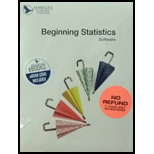
To construct:
And interpret a 99% confidence interval for the true mean difference between the weights to determine the mean amount of weight lost by doing on the diet.
Answer to Problem 11E
Solution:
The required confidence interval for the mean of paired differences is.
Explanation of Solution
Given Information:
A dietician wants to see how much weight a certain diet can help patients lose. Nine people agree to participate in her study. She weighs each patient at the beginning of the study and after 30 days of being on diet. The results are shown in table.
| Patients’ Weights (in Pounds) | |||||||||
| Starting Weight | 180 | 176 | 152 | 230 | 183 | 214 | 250 | 197 | 201 |
| Ending Weight | 172 | 167 | 144 | 219 | 172 | 201 | 239 | 186 | 195 |
Formula Used:
The paired difference for any pair data values of the two dependent samples are given by
Where
And
The mean of the paired differences is calculated as,
Where
Also n is the total number of data values.
The sample standard deviation of the paired differences is calculated as,
Where
And n is the total number of values given in the data.
For Margin of error we need critical value
The confidence interval is calculated as,
Where the lower endpoint is
Calculation:
| Starting Weight |
Ending Weight |
|||
| 180 | 172 | 1.77 | 3.1329 | |
| 176 | 167 | 0.77 | 0.5929 | |
| 152 | 144 | 1.77 | 3.1329 | |
| 230 | 219 | 1.5129 | ||
| 183 | 172 | 1.5129 | ||
| 214 | 201 | 10.4329 | ||
| 250 | 239 | 1.5129 | ||
| 197 | 186 | 1.5129 | ||
| 201 | 195 | 3.77 | 14.2129 | |
| Sum | 37.5561 |
The paired difference is calculated as,
Substitute 180 for
Proceed in the same manner to calculate
Substitute
Square the both sides of above equation.
Proceed in the same manner to calculate
The standard deviation of the paired difference is calculated as,
Substitute 37.5561 for
It is given that
To calculate the margin of error we need
Then,
The margin of error is calculated as,
Substitute 3.355 for
The confidence interval is,
Interpretation:
Since both the end points are negative so this implies that researchers are 99% confident that the mean difference between the weights was negative and lies between
Conclusion:
Thus the confidence interval for the mean of paired differences is.
Want to see more full solutions like this?
Chapter 9 Solutions
BEGINNING STATISTICS-CD (NEW ONLY)
 MATLAB: An Introduction with ApplicationsStatisticsISBN:9781119256830Author:Amos GilatPublisher:John Wiley & Sons Inc
MATLAB: An Introduction with ApplicationsStatisticsISBN:9781119256830Author:Amos GilatPublisher:John Wiley & Sons Inc Probability and Statistics for Engineering and th...StatisticsISBN:9781305251809Author:Jay L. DevorePublisher:Cengage Learning
Probability and Statistics for Engineering and th...StatisticsISBN:9781305251809Author:Jay L. DevorePublisher:Cengage Learning Statistics for The Behavioral Sciences (MindTap C...StatisticsISBN:9781305504912Author:Frederick J Gravetter, Larry B. WallnauPublisher:Cengage Learning
Statistics for The Behavioral Sciences (MindTap C...StatisticsISBN:9781305504912Author:Frederick J Gravetter, Larry B. WallnauPublisher:Cengage Learning Elementary Statistics: Picturing the World (7th E...StatisticsISBN:9780134683416Author:Ron Larson, Betsy FarberPublisher:PEARSON
Elementary Statistics: Picturing the World (7th E...StatisticsISBN:9780134683416Author:Ron Larson, Betsy FarberPublisher:PEARSON The Basic Practice of StatisticsStatisticsISBN:9781319042578Author:David S. Moore, William I. Notz, Michael A. FlignerPublisher:W. H. Freeman
The Basic Practice of StatisticsStatisticsISBN:9781319042578Author:David S. Moore, William I. Notz, Michael A. FlignerPublisher:W. H. Freeman Introduction to the Practice of StatisticsStatisticsISBN:9781319013387Author:David S. Moore, George P. McCabe, Bruce A. CraigPublisher:W. H. Freeman
Introduction to the Practice of StatisticsStatisticsISBN:9781319013387Author:David S. Moore, George P. McCabe, Bruce A. CraigPublisher:W. H. Freeman





